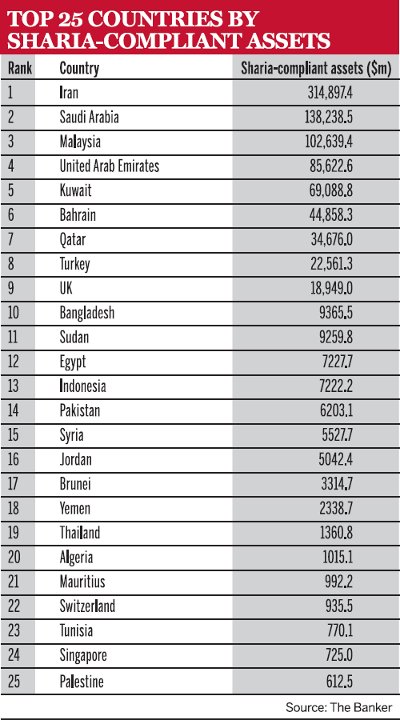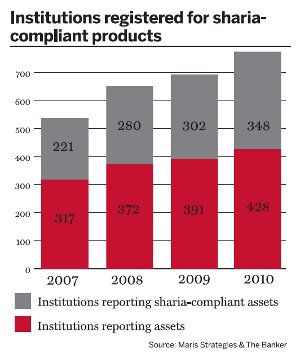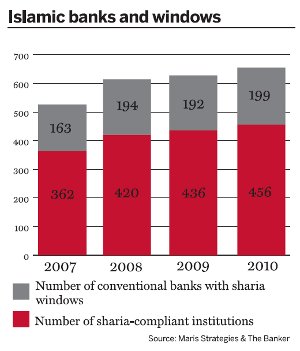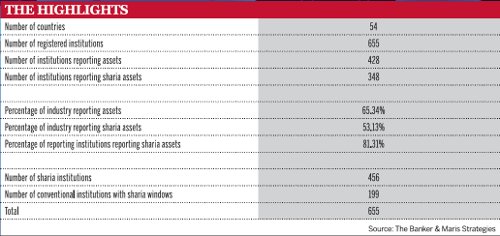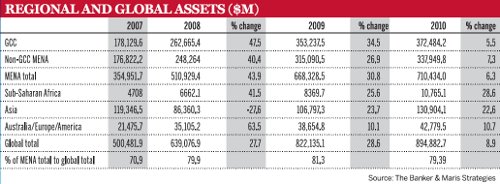The sharp fall in Gulf property markets has dampened confidence in a market that many expected to be relatively immune to the global financial crisis. But sharia-compliant assets are still growing, and perhaps tougher times will encourage a more sophisticated industry.
An old Arab proverb states that 'he who sees the calamity of other people finds his own calamity light'. This may be the best account of Islamic finance in 2010. As conventional markets struggle with the repercussions of the financial crisis, Islamic finance has continued an upward momentum.
The direct impact of the global crisis on sharia-compliant banking operations has been limited to institutions that access conventional capital markets or have participated in transactions requiring a group of banks to provide financing.
Islamic finance institutions were assaulted by the indirect effects of the crisis as property markets retreated from exorbitant growth rates in a number of regions, trade was reduced, tourism declined and foreign direct investment retreated. That said, since the publication of the first Top 500 Islamic Financial Institutions by The Banker in 2007, Islamic finance has continued to demonstrate upward growth despite growing pains and a loss of confidence in global financial systems.
Our 2010 survey of financial institutions practising Islamic finance reveals that sharia-compliant assets rose by 8.85% from $822bn in 2009 to $895bn in 2010. Islamic finance has held a compound annual growth rate (CAGR) of 23.46% from 2006 to 2010.
Many sharia-compliant institutions remain unscathed from the direct impact of the financial crisis. That said, indirect consequences of a global economic readjustment reduced the overall growth momentum of the industry from 2009's solid double-digit growth of 28.64% to single digits in 2010. Although the majority of sharia-compliant institutions report their financial activities in US dollars, part of the decline in growth rate can be attributed to a retreat of local currencies (outside the fixed currencies of the Gulf Co-operation Council, or GCC) against the US dollar during the reporting period.
More caution
Market optimism still present in 2009 has been replaced by a cautious risk posture in 2010 as bankers and central banks across the region take action to improve the quality of domestic markets. Even in areas relatively unaffected by the crisis, bankers are increasing their capital positions and adjusting lending attitudes to bolster confidence. In 2009, senior sharia-compliant bankers said that their success in riding out the financial storm could be attributed to the fact that Islamic finance is underpinned by tangible assets. However, as 2010 progressed, bankers realised that if those assets lost significant value, the attitudes of Islamic investors would likewise deteriorate rapidly. Asset quality has returned as a primary discriminator in bolstering investor confidence in Islamic finance.
Off-balance-sheet activity
The Islamic finance market continues to experience a widespread statistical latency whereby the reporting of financial numbers by institutions lags by several quarters, sometimes years. Although there is an increase in the number of reporting institutions, 47% of institutions are still not disclosing their sharia-compliant assets or providing very little insight into their operations.
The lack of clarity about which Islamic finance activities are on or off balance sheet opens the door to speculation on the transparency of the industry. Lack of clarity has led to an increase in discussions between organisations such as the Islamic Financial Services Board (IFSB), the Accounting and Auditing Organisation for Islamic Financial Institutions (AAOIFI), the International Monetary Fund and central banks aiming to improve overall reporting in the future.
Meanwhile, sharia scholars have engaged in debates about establishing industry standards for interpreting sharia principles. Perhaps a process of harmonisation of the limits defining what is haram (forbidden) and what is halal (lawful) will be necessary to clarify what constitutes a violation of sharia principles under various circumstances and interpretations. Bankers need a set of rules of what is acceptable to integrate into their risk/compliance systems, and to ensure that the highest level of sharia adherence is maintained.
More new banks
During the past year, 18 new banks offering sharia-compliant finance entered the market and six conventional banks began offering services via sharia-compliant windows. The rate of new market entrants has slowed from previous years (20 banks in 2009; 51 in 2008 and 78 in 2007). Islamic institutions are still seeing an influx of new customers in all parts of the world, partly brought on by the continued expansion of financial services infrastructure by central bank and government initiatives. Real-time gross settlement systems in many emerging market nations are enabling banks to reach new customers, and sharia-compliant retail bank operations are using technology to gain market share.
In August 2010, the Maldives Monetary Authority issued a licence to Maldives Islamic Bank Private, establishing the country's first sharia-compliant financial institution. Similarly, eastern Africa has proved to be particularly resilient as Muslims and non-Muslims are coming to Islamic banks in greater numbers. Kenya, Ethiopia, Tanzania and Uganda have all reported growing interest in sharia-compliant financing. In India, heated discussion is still ongoing about whether or not to offer sharia-compliant banking and finance.
One could argue that in the established markets for sharia-compliant finance, a consolidation of institutions might be around the corner, as logic suggests that once a country reaches a banking saturation point, banks begin to target the same customers. However, banks operating in the rapidly maturing markets of the GCC and Malaysia are maintaining their positions in domestic markets while turning their attention to expanding their customer base in other emerging nations. Sharia-compliant institutions are executing their growth strategies for transnational expansion in two distinct ways: organically and territorially.
In January 2010, Jordan Dubai Islamic Bank was launched as a transformation of the Industrial Development Bank under a joint venture between Jordan Dubai Capital and Dubai Islamic Bank. This co-operation between banks and government might be a sign of things to come as a means of leveraging the expertise of a bank such as Dubai Islamic Bank. China, France, Luxembourg, Australia, Sri Lanka and Mauritius have all expressed an interest in developing their countries' Islamic finance market.
Geographical expansion by Islamic finance institutions centres on commercial banking offerings and trade-related services. The transnational expansion of retail banking services is happening at a much slower pace as the investment required to launch services demands a higher degree of market understanding. Much of the expansion in retail banking depends on the proliferation of financial infrastructure, which is occurring at different rates in each country. In most emerging market economies, the cost of distribution (branches, ATMs and other physical means) is significantly higher than in Europe or the US; therefore, sharia-compliant bankers are developing strategies to leverage their investments in technology to engage unbanked segments of the population.
Profit challenges
During 2010, the global financial crisis tested the loyalty of the sharia-compliant investment market, as many institutions with high exposures in real-estate markets experienced a dramatic loss of value in their assets.
Placing the industry in a larger context across five years of data reveals unsurprising trends. The larger sharia-compliant institutions continued to deliver consistent asset growth and revenue growth, with numerous institutions maintaining double-digit growth over a five-year term.
Several banks have experienced difficulties with consistent profit generation, although their asset bases continued to grow. Smaller institutions were able to sustain substantial asset growth as they increased their market presence and focused their efforts on marketing and building domestic awareness. Other institutions increased profitability by consolidating operations to reduce cost-to-income ratios; a few took profits on their investments to maintain higher profits. That said, almost 80% of Islamic institutions fell in the 0% to 20% CAGR category for both profit growth and asset growth, which, contrasted against their conventional counterparts, commands a great deal of respect under the current financial environment.
During 2009-10, Dubai's property market faltered, causing widespread caution among Middle East investors. This rapid change in investor attitude had a direct impact on sharia-compliant banks in the region. Conventional and Islamic banks were equally affected, as many property deals in the region reflect co-operation between institutions. One characteristic that Islamic finance shares with its conventional counterpart is that all transactions are reliant on the creditworthiness of the parties. As creditworthiness is an integral part of debt-based financing, the value of underlying assets plays an integral part of asset-based Islamic finance.
Growing pains
To date, the Islamic finance industry has been quick to acknowledge the inherent shortcomings of an emerging industry: a shortage of talent, lack of standards and lack of availability. Steps have been taken to address each issue as numerous training organisations have emerged to teach the fundamentals of Islamic finance. To increase the quality of the industry, universities in Europe and the Middle East now offer degree courses on a multitude of Islamic finance disciplines. Organisations such as the AAOIFI, issuing 11 new sharia standards in 2010, and the IFSB are rapidly addressing the issue of standards. The key trend is that there is continued vigilance in observing market behaviour and developing standards to meet the changing needs of sharia-compliant finance.
During 2010, an east-west agreement took shape as the Bahrain-based International Islamic Financial Market collaborated with the New York-based International Swaps and Derivatives Association to develop a global standard for Islamic derivatives. This provides a tahawwut (hedging master agreement) structure whereby institutions can trade derivatives such as currency swaps. One clear new trend is that sharia-compliant organisations are striving to make Islamic finance available to more people regardless of their economic circumstances. From wealth management to microfinance, sharia-compliant transactions are becoming known to more people faster than their conventional counterparts.
One key issue that critics have begun to report is the 'faith tax', or the implication that sharia-compliant finance is more expensive that conventional finance, which can affect customer take-up of Islamic products. Academic papers and studies by the banks have revealed that Islamic finance is indeed more expensive to end-consumers and small and medium-sized enterprises (SMEs). Islamic banks are beginning to hear complaints from customers on the cost of sharia-complaint transactions and this will doubtless be one key issue that the industry will face in 2011.
That said, sharia-compliant institutions have fared better than conventional banks in the eyes of customers as the former are seen as prudent, higher quality and operating at a higher ethical standard. There is some truth in this perception, as conventional banks struggle to demonstrate their value to customers, while sharia-compliant banks are presenting themselves as ethical alternatives. Even the Vatican commented on how the ethical principles of Islamic finance might be an example for conventional banks to use to restore confidence in their customer base.
Liquidity management
Managing liquidity has been one of the challenges faced by the Islamic finance industry. During the past five years, a number of proposals have been advanced to address the problem of a lack of instruments available to sharia-compliant institutions to manage liquidity effectively. The government of Pakistan has introduced an Islamic interbank money market (Interbank Musharakah and Interbank Wakalah) and a sharia-compliant Islamic Interbank Offer Rate, to enable Islamic banks to lend excess funds to each other. In October 2010, the IFSB signed a memorandum of participation to establish the International Islamic Liquidity Management Corporation to facilitate more comprehensive liquidity management among institutions operating internationally.
The 8.85% asset growth of Islamic finance in 2010 appears anaemic; however, contrasted against the global banking industry, this modest growth is respectable. Islamic investors are becoming more sophisticated in their demands, and more vocal in any dissatisfaction with products and services.
Several key challenges such as SME financing and increasing the diversity of the sharia-compliant product portfolio are on the horizon for 2010 as Islamic finance follows the recovery of global markets. Building the brands of sharia-compliant finance and ethical banking will demand that institutions reposition their product portfolios with their target market segments to include both Muslim and non-Muslim customers. The global financial crisis has many lessons for both conventional and sharia-compliant financial institutions, one of which is that today's customer/investor perception is reality in terms of a bank's future performance.
Methodology
The Banker's Top 500 Islamic Financial Institutions listing assesses the global state of the Islamic banking and finance market today. Since 2007, the Top 500 has been regarded as one of the most credible mechanisms for estimating the size and growth-rate of the emerging Islamic financial marketplace. During each year of the survey, the market has experienced changes which can be associated with an industry in transition. The methodology used in the Top 500 strives to adapt to market changes while simultaneously maintaining our baseline method and preserving the statistical integrity readers expect from The Banker and Maris Strategies.
Our methodology begins with a compilation of the world's financial institutions offering sharia-compliant financial services from numerous publicly available sources. Central banks and government financial supervisory agencies have been consulted in order to identify the institutions registered to operate in each country. In countries where central banks and government agencies do not report Islamic financial institutions' details separately, sharia-compliant financial services were identified through a number of public and private agencies providing accounting and auditing services for those institutions.
Once the list of Islamic financial institutions has been compiled, annual reports and other publicly available information are collected, consolidated and confirmed. Institutions providing sharia-compliant financial services are requested to provide their latest financial data. Many responded with their annual reports and latest financial statements. However, an equal number elected not to supply information for the survey, and this is reflected on the listing as 'n/a' (not available). In many cases where institutions did not provide data, a public reporting requirement was not required by domestic regulatory authorities. The fragmentation in reporting indicates an industry in early developmental stages. For completeness, we have elected to include non-reporting institutions on this list to illustrate the diversity of the market.
Efforts were made to update the listing and maintain the level of consistency of the financial data. Wherever possible, collected data was verified from multiple sources and the financial details of the listed institutions were updated to the best of our knowledge. To minimise the effect of currency rate fluctuation when comparing the institutions, annualised foreign currency rates from the IMF Yearbook were used when converting local currencies to US dollars, and percentage-change was calculated from reported currencies before conversion into dollars. The basis for percentage-change calculation used figures reported in the previous ranking in order to illustrate the dynamics of the newly emerging industry, rather than exclusively using year-on-year figures.
One inherent problem with developing a topology of an emerging industry is the lack of a formalised structure that would allow the comparison of the underlying value of institutions with their relative contribution to the industry. Financial institutions such as commercial banks provide basic mechanisms for comparison, such as assets, profits and paid-up capital. Investment banks, insurance companies and other organisations engaged in financial services present a problem for inclusion into an industry benchmark based on deposit-taking, because the use of a measurement such as sharia-compliant assets does not accurately reflect the overall business activity or contribution they make to the industry as a whole. Therefore, we acknowledge that including these types of institutions with their full-service banking counterparts is akin to comparing apples to oranges. However, at this early stage of the industry development and for codification purposes they are included.
In this sense, we regard the latest sharia-compliant assets published by the institutions as the primary index in compiling the Top 500 listing. Even though we are fully aware of the shortcomings, we believe this to be the best available approach to illustrate the entirety of the market. Our intent is to continue to work with investment banks and insurance companies to develop a descriptive measure to reflect the role they play and the value generated in the market.
As the benchmark continues to evolve along with the market for Islamic finance, there is evidently a need for greater clarity in quantitative and qualitative reporting of sharia activities by banks, financial institutions and central banks. There are continuous efforts to improve the quality of data reported by institutions offering sharia-compliant financial services. The Top 500 assists in the facilitation of the industry's discussion of a uniformed reporting scheme and a higher degree of clarity in institutional data reporting.
CD 'Jay' Jung is a senior researcher at Maris Strategies specialising in African and Middle East economics.
Click here for further details of the Interactive tool and to purchase access.





